|
Historical Background
|
|
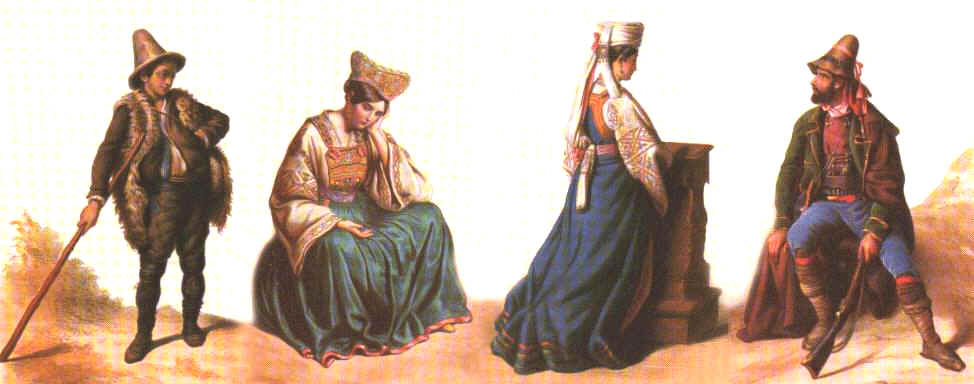
Calabrian dress -
1800's
|
Between 1890 and 1930, over 5 million Italians
immigrated to the
United States (not to mention an equal number that immigrated to
Canada, Australia, Argentina and Brazil) - 80% of them were from southern Italy. Bruno and Marianna were part of
that great exodus. They
did not think of themselves as Italians though, because
Italy
did not exist as a country, as we know it now, until 1871. They were Calabresi
from Calabria. Other Italian immigrants considered themselves Sicilian, Pugliese, Abruzzese, or
Napolitan depending on what part of the "boot" they were from.
What we now call
Italy was, for centuries after the fall of the Roman Empire, a collection of
city states and provinces controlled by other European countries.
During the mid 1800s, Giuseppe Garibaldi headed a revolutionary movement
- the Risorgimento, to overthrow foreign rule and unify
all the provinces into
one nation. To
gain support for the rebellion, sweeping promises for a better future were
made to all the provinces. Those in the southern provinces felt they had
the most to gain and many young men from southern Italy rushed to fill the ranks of Garibaldis army.
They saw the chance to get revenge for years of harsh foreign
oppression (especially from the French) and to liberate themselves from
impoverished peasantry. The
rebellion was successful and the
Republic
of
Italy
was born.
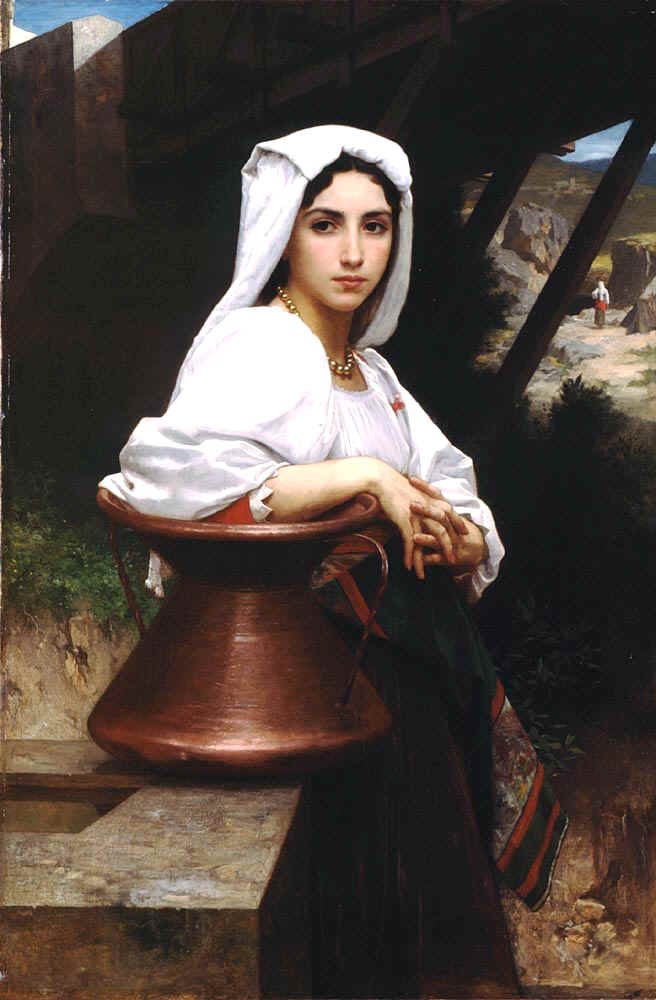
It was said that, Italians are as attached to their soil as an oyster
to its rock. Why then would
so many of them, like Bruno, want to take their families and leave
everything they held dear - their homes, villages and farms the land
their ancestors had lived on for centuries, just when a brighter future
seemed right at hand? The
answer is tied to a number of significant political events, economic
problems and natural disasters that impacted southern Italy in the late 1800s.
The great promises of the Risorgimento were slow to come to southern Italy.
Northern Italy
was more industrialized, the people better educated and far better off
economically than the south. The southern provinces were rural, rustic and
had agriculture based economies. They had little industry and were isolated from the big cities
and centers of arts and science. Because of that, southern
Italians were generally considered low and backwards by northern Italians. Those differences, developed into longstanding regional
animosities and tension between the provinces.
Since the
northern regions
were already flourishing and prosperous, their interests became the main
focus of the Italian parliament. The
first extensive rail system in
Italy
connected the northern industrial city of
Turin
with
Paris, not
Turin
with
Naples. While the rest of the
country was advancing and improving the lives of their people, the south
was left to manage on its own. Opportunities
for a better life seemed farther and farther away.
A
number of natural disasters
also hit southern Italy
about this time. During the 19th
century, southern
Italy
was notorious as the most malarial area in
Europe. On top of that, a series of
cholera epidemics swept through the south
between 1884 1887 that took the lives of 55,000 people.
Worst of all, the provinces of Calabria and Sicily were hit with
four major earthquakes in quick succession -1894, 1905, 1907 and
1908. The quake of 1908 was the most devastating, also
producing a tidal wave that destroyed most
of the coastal towns in the Sicilian province
of
Messina
and much of
the southwestern coast of Calabria
The dead
numbered almost 100,000. The
tidal wave reached a height of 40 ft, and for five days torrential rains
totally flooded the
provinces. Many
of those who lived to tell the story interpreted the disaster as nothing
less than a signal from
Providence
and joined the migration of Sicilians and Calabrians to the United States.
America
looked very appealing. The
oysters were leaving their rocks.
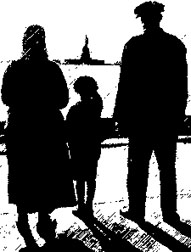
To
"L'America"
In May 1895,
Giacomo Bruno Fuscà, then
30 years old, along with his older brother Domenico, 35, and two
cousins,
Giuseppe DeCaria
and Giuseppe Scuglia left the
village
of
Vazzano
and made their way to Naples where they boarded the passenger
ship, SS Britannia, that would take them to
America. Bruno left behind his wife Marianna Nicolina DePalma, 28, and three young sons Giuseppe Maria,
age 7, Domenico
Antonio, age 4, and Francesco Giovan Battista, age 1 -
Joe, Don and Frank. Marianna came from a good family
in Pizzoni, the next town. She was the daughter of
Giovan Battista DePalma and Caterina Donato.
On their Certificate of Marriage, Bruno is listed as a calzoliao
- a shoemaker, Marianna is listed as a filatrice - a weaver. Later records give
her the title "donna de casa" - literally, Gentlewoman of the
house. This was a title of respect, it did not simply mean a
housewife.
|
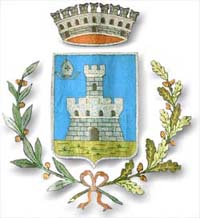
Vazzano
Town Crest |
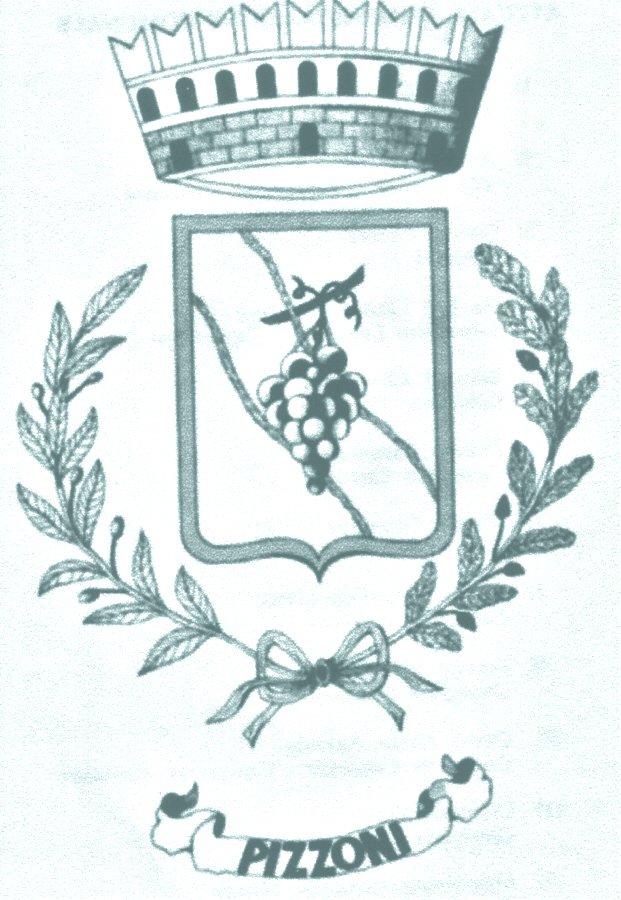
Pizzoni
Town Crest
|
As a side note here,
both Bruno and his brother Domenico could read and write. The
passenger manifest for the SS Britannia states this and signatures, in their own hand, by Bruno and his two brothers
Domenico and Francesco are often found on Civil Documents in Vazzano where
they signed their names as witnesses attesting to births, deaths and
marriages in the 1880s and 1890s.
In fact, Francesco was the sindaco
mayor, of Vazzano during
the 1890s. The Civil
Records of marriages, births and deaths are revealing in other ways too
because they list the profession the person the Record concerns.
It is clear that our branch of the Fuscà family were members of the artisan class and
were well
educated for the time. Quite a few of our direct ancestors had the title Mastro
- master/teacher. They were not peasants without hope, fleeing to
America. They came for well thought-through
reasons.
Bruno,
Domenico and their cousins
arrived in the port of New York on June 13 and were processed through
immigration at Ellis Island. They then went by
rail to their final destination, Johnsonburg, Pennsylvania. They had been
sponsored by one of the families who had come over earlier, possibly
the Malfera family or, more likely, the DeCaria family. They recruited many young men looking to come to America from Vazzano, Pizzoni and
the nearby towns of San Nicola da Crissa and Vallelonga to work as laborers in the
then thriving, industrial town of
Johnsonburg - work, such as cutting timber, brick manufacturing or working
in the paper mills. The sponsoring families did more than simply bring over laborers
for local industry. They felt an obligation and responsibility to look
after their welfare. In fact, Caterina DeCaria, the matriarch of the
DeCaria family, was known as Queen
Caterina to the immigrants. When she died, her body was preserved in a
glass coffin and placed in a mausoleum. Today, 24% of the
population of Johnsonburg still
claims Italian ancestry.

Johnsonburg,
Pennsylvania in 1895
Bruno
did not stay in Johnsonburg long, maybe a year. He left Johnsonburg
and moved to Braddock. PA working as a laborer for the Pennsylvania
Railroad. In 1897 with the money he saved, he bought a two room
building at 1314 Montier Street in Wilkinsburg. The following
year, he sent for Marianna and the boys.
|
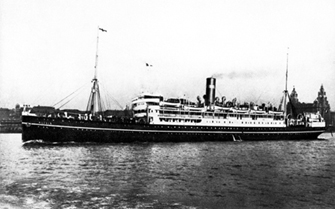
SS
Alesia |
Marianna,
Joe, Don, Frank came over with Bruno's nephew, Giuseppe Fuscà, 21, on the SS
Alesia.
The Alesia left out of the Port of Naples on
September 5, 1898 and arrived in New York on the 24th. The ships manifest shows
Marianna had the grand sum of $10 to her name!
In 1900,
Elizabeth
was born. A year later, Bruno
bought a house two blocks away at 1517 Montier Street. He built double storerooms
downstairs one for making shoes and boots and in the other, he sold
food and ice cream. The
store was simply referred to as Brunos. The
family grew with the arrivals of Catherine in 1902,
Jack
in 1904, Richard in 1908 and Vic in 1913.
The children worked in the store and the businesses did
well. In 1918, they moved to 1124 Maple Street
on the hillside above the store on Montier Street. Bruno
converted the old building below into a grocery and general merchandise store, where
he gained the reputation If Bruno doesnt have it, nobody does.
The store served the community for over 30 years.
Grocery store chains were coming
into the neighborhoods by the 1920s and automobiles were quickly
replacing the horse and wagon. To
keep pace with changing times and to keep his business interests thriving, Bruno
opened a gas station and garage.
Bruno died in 1933 at the age of
68 and Marianna the following year at 66.
They are buried along side Bruno's brother Domenico and his wife
Maria Carmella (Facciolo) Fusca, Mary Fusca and Salvatore J. Fusca
in Monongahela Cemetery, North Braddock, PA.
I would like to specially thank
Josephine Nuzzo Fusia for her help, knowledge and wonderful sense of humor.
I wish she was still with us. Much of
the details above came from her.
Mille grazie, zia
Josephine!
Si, il sangue tira.
Tom Fusia
_____________________________________________________________________________________
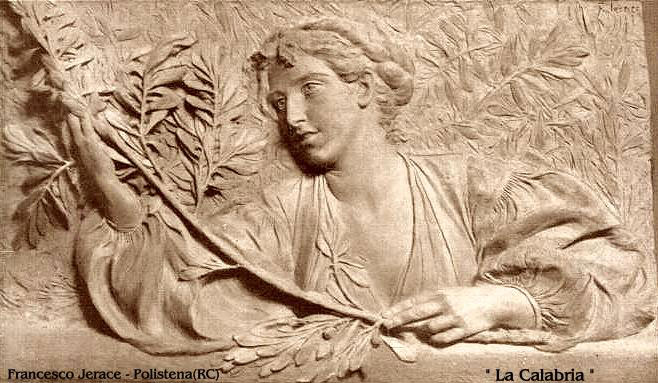
La
Calabria
____________________________________________________________________________________
OK, so where are Vazzano and Pizzoni ?
The surrounding countryside is beautiful with rolling
hills.
For photos click HERE
Vazzano and Pizzoni are small agricultural towns
(population about 1200 each) in Vibo Valentia Province, Calabria.
They are about a mile from each other. Calabria is the southernmost Region in
mainland Italy - The "Toe" of the "Boot".
It
is the ahh... fuchsia
colored Region on the map below -
|

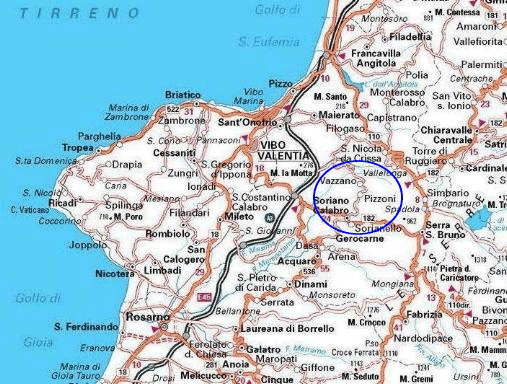
|

Pillars of
a Nation
painting by
Jim Daly
_______________________________________________________
The
Myth of Ellis Island Name Changes
Immigrants'
surnames were changed
thousands of times, but professional researchers have found that name
changes were rare at Ellis Island (or at
Castle
Island
, which was the
New York
port of entry prior to
Ellis Island
's opening). The myth of name changes usually revolves around the concept
that the immigrant was unable to communicate properly with the
English-speaking officials at
Ellis Island. However, this ignores the fact that
Ellis Island
employed hundreds of translators who could speak, read, and write the
immigrants' native tongues. It also ignores all the documentation that an
immigrant needed to have in order to be admitted into the
U.S.
In order to be admitted into the
United States
as an immigrant in the late nineteenth century or later, one had to have
paperwork. Each immigrant had to have proof of identity. This would be a
piece of paperwork filled out in "the old country" by a clerk
who knew the language, and the paperwork would be filled out in the local
language, not in English (unless the "old country" was an
English-speaking country). The spelling of names on these documents
generally conformed to local spellings within the immigrant's place of
origin. Even if the person traveling was illiterate and did not know how
to spell his or her own name, the clerks filling out the paperwork knew
the spelling of that name in the local language or could sound it out
properly according to the conventions of the language used. Also, in many
countries one had to obtain an exit visa in order to leave. Again, exit
visas had to be filled out by local clerks who knew the language, and exit
visas were written in the local language.
A ship's passenger list had to be prepared by the captain of the ship or
his representatives before the ship left the old country. This list was
created from the travelers' documents. These documents were created when
the immigrant purchased his or her ticket. It is unlikely that anyone at
the local steamship office was unable to communicate with this man. Even
when the clerk selling the ticket did not speak the language of the
would-be emigrant, someone had to be called in to interpret. Also,
required exit visas and other paperwork had to be examined by ticket
agents before a ticket would be sold. The name was most likely recorded
with a high degree of accuracy at that time.
Next, the ship's captain or designated representative would examine each
passenger's paperwork. The ship's officials might not know the immigrant's
language, but they had to inspect the exit visa and the proof of identity.
They knew that immigrants would not be accepted into
Ellis Island
without proper documentation and, if the paperwork wasn't there, the
passengers would be sent back home at the shipping company's expense! You
can believe that the ship's owners went to great lengths to insure the
accuracy of the paperwork, including names, places of birth and travel
plans. It is believed that many more people were turned away at the point
of embarkation than were ever turned away at
Ellis Island
. In other words, most of those without proper documentation never got on
board the ship.
When the ship arrived at
Ellis Island
, the captain or his representative would disembark first with the
passenger list. The
Ellis Island
officials would then bring in interpreters to handle the interrogations.
These interpreters were usually earlier immigrants themselves or the
children of immigrants, and they all knew how to speak, read and write the
language of the immigrants.
The usual immigrant processing time was one to three days. During this
time, each immigrant was questioned about his/her identity, and all the
required documentation was examined in detail. Keep in mind that this was
not a quick two or three-minute conversation such as we have today at
international airports. In the days of steamships, the
Ellis Island
officials had the luxury of time. They could make leisurely examinations.
The questioning at
Ellis Island
would be done in the immigrant's native tongue. While the immigrant often
was illiterate, the interpreter doing the questioning always could read
and write the language involved.
Ellis Island
employed interpreters for Yiddish, Russian, Lithuanian and all of the
European languages. The immigration center in
San Francisco
did the same for all the Chinese dialects as well as Japanese, Korean, and
many more Oriental languages. Other immigration centers in
Boston
,
Philadelphia
,
New Orleans
,
Galveston
and elsewhere followed similar procedures.
Anyone who did not have proper paperwork (in the native language) showing
the correct name and place of birth was sent back. Many thousands were
sent back for identification reasons or for medical reasons or because
they did not have sponsors in the
U.S.
Most of the people who came through
Ellis Island
did so with correct paperwork showing the correct or at least plausible
spellings of their real names in their original language.
There were a very few exceptions, however. Occasionally war refugees were
admitted without much documentation. This was especially true in 1945 and
1946. A few others succeeded in falsifying documents in order to gain
admittance when they could not be admitted under their true identities.
Occasionally a child was admitted under the surname of a stepfather when
the name of the natural father would have been more appropriate. Nobody
can document the number of exceptions, but most professional researchers
believe that the number of exceptions was very small.
Once settled into their new homes, however,
anything could happen. Millions of immigrants had their names changed
voluntarily or by clerks or by schoolteachers who couldn't pronounce or
spell children's names. Some immigrants changed their names in order to
obtain employment. Many immigrants found it easier to assimilate into
American culture if they had American-sounding names, so they gladly went
along with whatever their neighbors or schoolteachers called them.
However, the records at
Ellis Island
remained in the original language.
For
more information about the myth that "the family name was changed at
Ellis Island
," look at the U.S. Immigration and Naturalization's Web page at:
http://www.ins.usdoj.gov/graphics/aboutins/history/articles/NameEssay.html
|
|
From
the book Polyglot Italy:
The Greeks In
Southern Italy
by Dr. Geoffrey Hull
In
ancient times
Sicily
and the
Italian
Peninsula
south of
Naples
were known collectively as Magna Graecia - 'Great
Greece
' because of the number and importance of the Greek settlements there.
The coasts of Apulia,
Lucania
,
Campania
,
Calabria
and eastern
Sicily
were first colonized by mainland Greeks in the eighth century before
Christ.
The expanding Roman Empire had annexed the whole of Magna Graecia and
Sicily
by 241 B.C., and while the Romans planted Latin colonies here and there,
on the whole they treated the Italian Greeks as confederates, respecting
their language and culture. In
Rome
itself Greek was employed as a second language and in the first Christian
centuries the city had a large Greek-speaking minority. Latin spread
through the Greek cities of the South as an administrative language but
Greek held its own as a literary medium and the speech of the common
people in many areas. At the height of the Empire Vulgar Latin had
inplanted itself as the vernacular only as far south as the Apulian towns
of Tarentum and Brundisium, and the river Crati in Bruttium (present-day
Calabria), the Salentine peninsula, lower Calabria and eastern Sicily
remained for the time being strongholds of the Greek language.
There is evidence that Greek continued to be widely spoken in
Calabria
(at least by the lower classes) until the Renaissance period. The
anonymous author of a French chronicle of the late thirteenth century
noted that "through the whole of
Calabria
the peasants speak nothing but Greek". In 1368 Petrarca
recommended a stay in the region to a student who needed to improve his
knowledge of Greek.
In the early sixteenth century Calabrian Greek was still vigorous in the
inland districts south of Palmi and Cittanova but by the close of the
seventeenth century it had receded into the Aspromonte mountains of the
southern tip of the peninsula, an area comprising hte towns of Cardeto,
Bagaladi, Motta San Giovanni, San Lorenzo, Melito, Condofuri, Roghudi,
Bova, Palizzi, Africo and Sant'Agata. For the next century and a half the
Calabrian Grecia (Greek-speaking zone) remained fairly stable,
until the Risorgimento and Unification unleased a new tide of Italian
linguisitic influence which accelerated the process of erosion. By the
1920's the ancestral language of
South Calabrians
could be heard only in the small rural communites of Bova, Amendola,
Condofuri, Galliciano, Roccaforte, Roghudi and Ghorio.
By the time they became citizens of the Kingdom of Italy in 1861, the
Italo-Greeks, mostly poor peasants, had long been severed from the
Byzantine religious traditions and from the mainstream of Neo-Hellenic
civilization, The modern Italiot renaissance began in the Salentine Grecia
through the efforts of Vito Domenico Palumbo (1857 - 1918), a native of
Calimera, who endeavoured to re-establish cultural contacts with
mainland Greece. Although excluded from the churches, schools and
government offices, Greek began to be taught in some villages in the
decade following World War II on the initiative of private individuals. In
1971 the Unione dei Greci dell'Italia meridionale was founded to
foster relations between the Calabrian Greeks (today numbering only 5,000)
and the 15,000 Salentine Greeks. At least three bilingual journals devoted
to the Griko language are now in circulation, and a number of
mainland Greek intellectuals and cultural bodies have taken an interest in
the welfare of their trans-Ionian brothers. Nevertheless, in spite of
these developments, Italo-Greek continues to be ignored the the Italian
government. Furthermore the Calabrian Grecia, already in an advanced state
of decay, suffered a serious setback when the floods of 1970 and 1972
forced the evacuation of Roghudi and Ghorio. The inhabitants of these
villages have since been resettled along the Ionian coast and in Reggio
where the language has little hope of survival.
Ample traces of the recent Greek past of Calabria, Salento and
north-eastern Sicily remain in the local Neo-Italian dialects (the Romance
speech that replaced Greek), and in regional surnames like Argurio
('Silver coin'), Calabro ('Calabrian'), Calo, Cala ('good'), Cefali
('head'), Chiriaco ('lordly'), Condro ('fat'), Dascoli ('Teacher'), Foti
('bright'), Lagana ('greengrocer'), Lico ('wolf'), Macri ('long'),
Papandrea ('the priest Andrew'), Patera ('father'), Pangallo ('very
good'), Schiro ('hard'), Sgro ('curly-headed'), Spano ('beardless'), Trano
('adult'), Tripodi ('tripod'). The Hellenisms in the modern South
Calabrian dialect include such common words as ciaramide 'tile',
ahjeri'dish-rag', crasentulu 'worm', capura 'pail', scifu 'trough', tripu
'hole', cudespina 'old woman', cuddaraci 'Easter bun', fusca 'bran',
hasmiari 'to yawn', milinghi 'temples', spissida 'spark', cilona
'tortoise', petula 'butterfly', praia 'beach', rosacu 'frog', zafrata
'lizard', and zimmaru 'ram'. South Calabrian offers many examples of Greek
syntax in Romance dress, for example the periphrastic construction that
replaces the Italian infinitive, e.g. vogghiu mu vajo 'I want to go'
(literally: "I want that I go") = Bova Greek thelo na pao (It.
Voglio andare), vinni mi ti dugnu 'I came to give you' = irta na su dhosu
(It. Venni a darti). Similarly, the use of the preterite tense instead of
the Italian present perfect betrays a recent Greek substratum, e.g. comu
mangiasti? 'how have you eatern?' = local Greek pos efaje? (It. Come hai
mangiato?), ci facistivu? 'what have you done?' = ti ecamete (It. Che cosa
avete fatto?).
|
|
Description of Calabria in 1589
By
Gabriel Barrius Franciscanus
CALABRIA, a country of Italie in form and
fashion not unlike a tongue, lies between the upper and lower seas. It
begins at the lower sea (the Greeks call it the Tyrrhen sea, the Romans
the Mediterranean or Midland-sea) from the river Talao, which runs into
the
Bay
of
Policastro.
At
the upper sea (the Ionian sea is what the Greek call it), the river Siris
(also once called Senno) flows along until it comes to the straights of
Faro di Messina and the city of
Reggio
. And then, being divided into two by the mountain range Apennine (here
they call it Aspromonte) it ends at two capes or promontories, one called
Leucopetra (by them Capo de Leucopetra), the other Lacinium (vulgarly by
them called Cabo delle colonne or Cabo dell'Alice).
Not
only the plains and the fields, but even the hilly places, as is the case
in
Latium
or
Campania
are well provided with water.
Whatever is necessary for the maintenance of mans life is yielded by this
country in great abundance, so it needs no foreign commodities but is able
to live of what it provides by itself. In general,
Calabria
has a good and fertile soil, and
it is not bothered by
Fens
, Lakes and Bogs, but is always green, affording good pastures for cattle
and excellent grounds for all sorts of grain. The fountains and brooks are
numerous, and fairly clear and wholesome.
The
sunny hills and mountains, open to every cool blast of wind, are
wonderfully fertile for corn, vines and trees of various kinds, which
provide great profit to its inhabitants. The valleys are pleasant and
fruitful. The shady groves and woods afford many pleasures and delights.
The excellent meadows and pastures are richly covered with herbs and sweet
smelling flowers, and ever running streams. And among other things, here
is plenty of wholesome food with which they feed and fatten their cattle.
Here also grow many medicinal herbs of sovereign virtues, against various
different diseases.
It
brings forth various plants, such as the Plane tree, Vitex or Agnus castus,
the Turpentine tree, the Olive tree, Siliqua Silvestris, Arbute or
Strawberry tree, wild Saffron, Madder, Licorice, and Tubera or Sowbread.
It also has some hot baths, continually issuing from their springs, which
cure aches and many other similar illnesses. In various places there are
salt water springs of which they make some kind of brine or pickle. It is
well watered by many fine rivers, and those are well provided with various
kinds of fresh water fish. The sea on each side also yields plenty of
fish, tunas as well as sword-fishes and lampreys. In many places here the
best Coral is found, both white and red.
Here
hunting and hawking is most pleasant, for in these places various
different sorts of wild beasts live, and as many birds and fowls breed and
build nests here. Then there are wild boars, deer, hinds, goats, hares,
foxes, lynxes, otters, squirrels, martens, badgers, ferrets, porcupines,
and tortoises, both of the water and of the land. It is everywhere full of
fowls, pheasants, partridges, quails, wood-cocks, ring-doves, crows &c.
as also of many kinds of hawks. It maintains some herds of cattle and
flocks of sheep and goats. It breeds excellent horses, very swift and of
great courage.
Metals were found here in old times, and to this day it still abounds with
various kinds of minerals, having indeed everywhere mines with gold,
silver, iron, salt, marble, alabaster, crystal, marcasite, red lead or
vermilion, copper, alume, brimstone &c. Also many kinds of corn,
wheat, silage, beer-barley, rye, trimino (we call it Turkey wheat I
think), barly, rice, and sesame, all in infinite quantities. It also
abounds with all kinds of pulse (legumina the Romans call it), oil, wine,
and honey, all the best of their kind.
There are here everywhere orchards full of oranges, lemons and Pome lemon
trees. They also make plenty of excellent silk here, far better than any
kind of silk made in other places in Italie. The cotton bush (Gossipium)
grows here plentifully. But what shall I say about the kind temperature of
the air? For here the fields both in winter and summer are continually
green. But above all things, there is nothing which makes my point more
soundly than that airy dew or heavenly honey which they call Manna that
comes down everywhere from above, and is here gathered in great abundance.
So that which the Israelites in the wilderness admired and considered as a
strange wonder, is here provided by kind nature of her own accord.
It
is also adorned with many good market towns, where markets and fairs are
held at certain times of the year. In some places here the ancient custom
of the Romans is still preserved at funerals and burials of the dead,
where a chief mourner (Praefica they call her) is hired to go in front of
the mourners guiding their mournful rituals, keeping time to their howling
lamentations. The funeral being done and all ceremonies performed, the
dead persons friends and kindred, bringing their own food and picnic gear,
banquet all together at the dead persons house.
The women of this country as a matter of course, out of modesty or because
the water of this area is good and wholesome, drink nothing but water. It
is considered to be a shame for any woman to drink wine, except if she is
very old, or is in childbirth.
|
|
Political
Graffiti
from Pompeii 79 A.D.
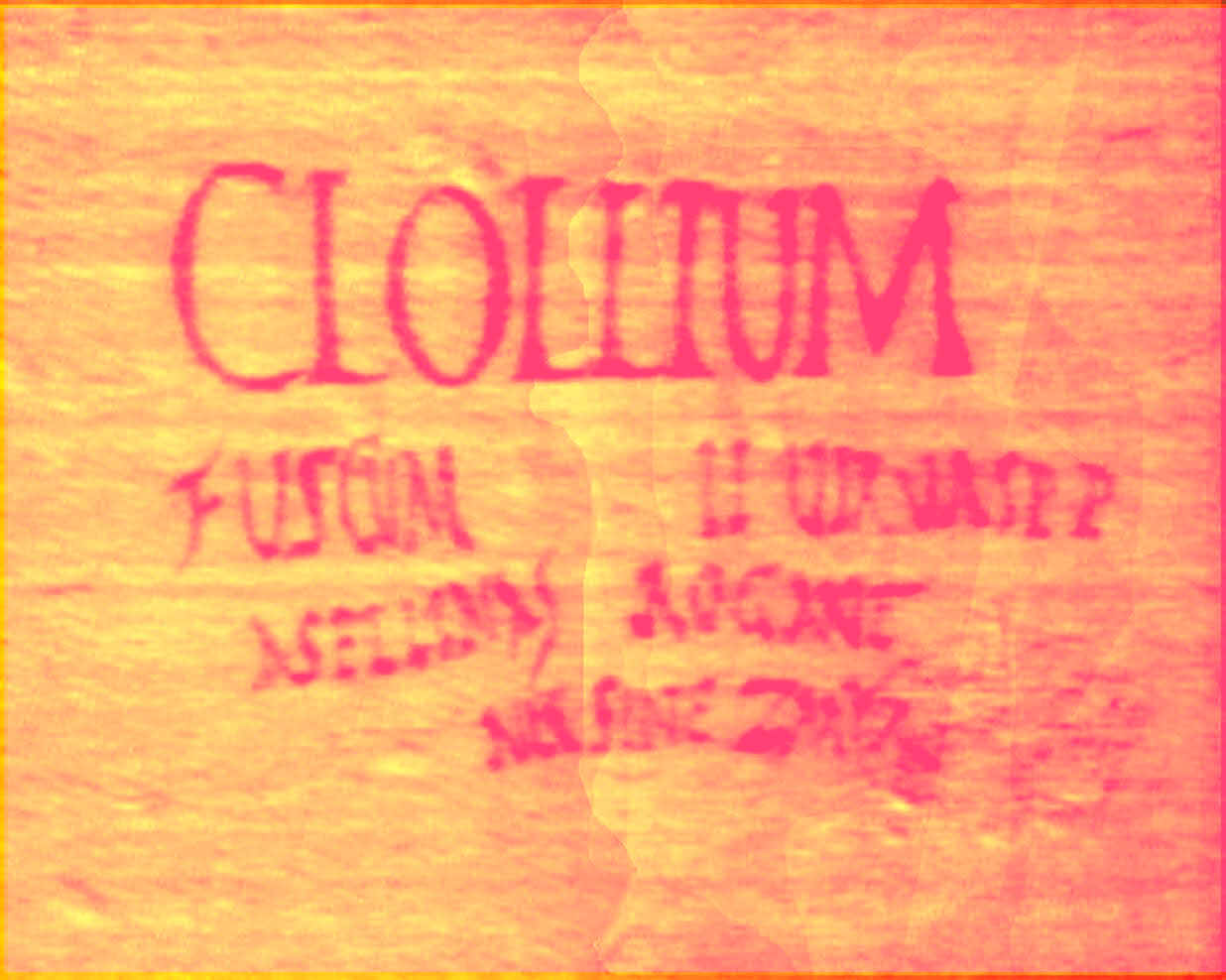
Translation:
"Asellina
and her girls urge you to vote for Gaius Lollius Fuscus
for
Minister of Public Affairs"
Note: Asellina
ran an "entertainment house" in Pompeii. This
was written on the outside wall of her establishment.
|
|
|
|
 The Fusia and Fuscà
Families
The Fusia and Fuscà
Families

![]()